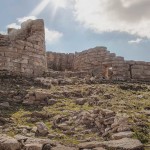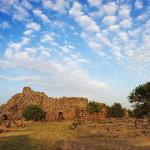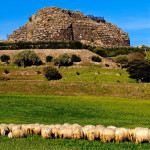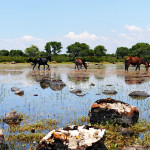FROM HEINRICH SCHLIEMANN TO INDIANA JONES. Sardinia has always been a popular island for tourists, ever since the Paleothic era when it was practically uninhabited
From the ancient Neolithic . (6000 BC) the first settlements came into being which would later give birth to one of the most civilisations in the entire Mediterranean, from whom the present day Sardinians are direct descendents Going forward a little in time we find many prehistoric remains going back to. 3000 BC , but it was later (1800-1600 BC) that the mysterious and intriguing civilisation of the Nuraghe came into being which created the megalithic architecture in Sardinia; imposing structurs like Su Nuraxi, Nuraxi ‘and Cresia. Genna Maria and other nuraghe for centuries assumed the role of centres around which flowed the life of local communities. Although there have been many theories about their effective function – storehouses, watch towers, fortresses, strongholds for tribal leaders, religious centres and who knows what else, still today no hypothesis prevails over the others
This uncertainty makes these monumental works of nuraghic man real mysteries that may keep their millenary secrets for eternity.
Orroli − Nuraghe Arrubiu
Around Orroli there is an archaelogical site of exceptional interest the centre of which is Nuraghe Arrubiu (red nuraghe), one of the biggest on the island, dating back to 1400 BC It is well worth a visit, think that the central tower is 16 metres high (originally 27metres) and is surrounded by no less than 5 smaller towers. Inside there is a courtyard where you can find another 8 towers, strong defensive walls and a village which was inhabited up to Roman times. This is the only. “pentalobato” nuraghe in Sardinia and covers an areas of 5000 square metres, ( this would cost a lot of money to buy nowadays!) Its imposing structure is constructed of red basalt from which it takes its name Arrubiu (red). In the biggest tower you can admire the tholos (dome) which is perfectly intact, there is even a treasure buried in the middle of a mass of ash. A perfectly preserved votive vase used for propitiuary rites towards some divinity. Archaelogists have found many remains of large amphorae used for alimentary storage, while one of the towers (named chamber of the ladies) has provided a large number of everyday objects.
Serri −Nuragicic Sanctuary of Santa Vittoria
The sanctuary lies in the giara of Serri and is about 600 mt above sea level, it covers a surface of about 4 hectares and offers a panoramic view of the surrounding countryside. It was uncovered by Antonio Taramelli (1868 – 1939) between 1907 and 1929, giving back to us a nuragic village from between 1600 and 900 BC. After a period of abandonment the village was again inhabited in the Punic era (600 – 300 BC) then by the Romans (300 BC – 200 AD) and finally by the Byzantines (600 – 900 AD). The archaelogical area is divided into sectors, amongst which the Holy and the Civil, the former developed around the well, a stupendous architectural example of a time when religious rites animated all the social life of the nuragic civilisation; the second being distinguished by a large fence, maybe used for festivals or for when there were stock markets on occasions of religious celebrations.
In conclusion the nuragic period is shrouded in mystery and unfortunately all we know is based on hypothesis.
Barumini − Su Nuraxi
The imposing archaelogical complex of Su Nuraxi di Barumini was completely uncovered between 1949 and 1956, under the direction of the archeologist Giovanni Lilliu. Unesco declared it to be“Common heritage of mankind”, and it’s the most impressive of all the Nuragic complexes now considered to be one of the symbols of Sardinia
Rising in the west of the town of Barumini,on the western borders of Sarcidano and Marmilla, on a dominating tor above the vast plain, at an altitude of 238 metres above sea level. Its profile stands out unmistakeably on the horizon of the high plains of the Giara di Gesturi. The oldest construction goes back to 1450 BC amd it was modified and expanded over the centuries untili t reached its present size The excavations have shown the various stages of the construction of the main building and the surrounding village, confirming the continuity of habitation up to the first century AD, in the Roman period. Entrance costs . €7 full price and €5 reduced (Under 18).
Barumini – Palazzo Zapata / Nuraxi and Cresia
Sometimes history gives us some real suprise, some extraordinary coincidences: it would be like discovering that there is a pyramid under the Egyptian museum in Cairo * Why do I say this? Think that at Barumini, during the work of restoration under the foundations of the Palazzo Zapata – destined to house the museum of the Nuragic civilisation, there was an incredible discovery, the awesome Nuragic complex named Nuraxi ‘and Cresia.
Included in the price of the entry ticket to Nuraxi is a guided tour of the archaelogical site, a visit to the Palazzo Zapata and also entrance into the Lilliu congress centre which has a permanent art exhibition.
Gesturi − La giara
Walking on the Giara, following its 14 km long path through the sings that man has left over 3500 years, is an extrasensorial experience 45 square kilometres of rock, woods of holm oak and cork, the typical flora known as ‘macchia mediterranea’, with a very high concentration of botanic species in an area that is preserved to resemble a natural museum, once surrounded and maybe even defended by 23 Nuraghe. All of this is the Giara of Gesturi, a basaltic high plain of volcanic origin , fruit of nature’s capricious creativity. Situated in the centre of Southern Sardinia west of the gulf of Orestano , between Marmilla, Trexenta, Sarcidano and Arborèa, the giara includes the communities of Gesturi, Tuili, Setzu and di Genoni extending over an area of 42 square kms about 600 metres above sea level.
The Italian name ‘giara’ is from the Sardinian ‘jara’ , used to indicate various basaltic high plains, in fadt besides the antonomasian giara – of gesturi – the re are also the giaras of Siddi and Serri. The term probably derives from ‘glarea’, or ‘ghiaia’, coarse gravel mixed with shingle which covers the entire surface of the zone. The giara of Gesturi is internationally famous because of the wild horses which live there, perfectly in tune with the environment. This animal (Equus Caballus Giarae) is a mix between a horse and a pony and has a dark coat. The average height is about 1.2 metres (withers) It has been on the plain since ancient time sas it’s remains in archaelogical sites can testify. In the charcteristic ‘paulis’, depressions where the basalt rock holds water, you may see the horses peacefully grazing. In the right season you can aslo see the spectacular flowering of cyclamens, violets and splendidly coloured orchids, as well as wild saffron (zaffaranu), anemones, daisies, margherite, cornflowers, hawthorns and pear trees. I hope you’re convinced!
Isili – Nuraghe Is Paras
Reaching Isili, Sardinia, means a journey into historical ages, which express their tangible reality in various nuraghi emerging on the hill tops. Among them, on a hill outside North Isili, stands the Nuraghe Is Paras, a valuable archaeological site, whose name originates from the one of some fraternities of Scolopi monks who inhabited this land between the seventh and the nineteenth century. Nuraghe Is Paras, or white giant, so named for the material used and its mighty size, has a three-lobed bastion, surrounded by mighty walls embracing the tower. One can access the tower through an opening that leads to the backyard: it is a circular room with a well mouth in its center. Eleven steps of the spiral staircase leading to the upper chamber have survived, while all around lie the remains of several towers, but the memory only survives for three of them.
Villanovafranca – Nuraghe Su Mulinu

In Sardinia, in the town of Villanovafranca, on a hillside above the river Mannu, lies the archaeological site Nuraghe Su Mulinu. When you are on the Highway 131, at Sanluri, take the SS 197 and, after Villamar, take the turning to Villanovafranca. Once in the centre, follow the signs and after 1 km you’ll arrive at the site. Nuraghe Su Mulinu is a testament to the Middle Bronze Age with prehistoric buildings made of blocks of marl. The plan is not fully understood but the different construction phases are clear. During the first phase, from the sixteenth to the fifteenth century BC, the three-lobed bastion was erected, while in the second phase, in the fourteenth century, the rampart was added . The third phase dates from the twelfth century BC when the tower F was built with entrances to the compartment F1. In the E area, used as a place of worship a splendid nuragic sandstone altar, richly decorated, was discovered.



